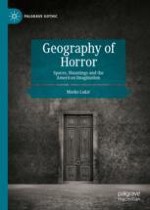Abstract
A possible entry point into the debate and analysis of the issue of space and place as it relates to the imaginary geography of the American horror genre can be achieved through an analytic deconstruction of Stephen King’s novel ‘Salem’s Lot. The now classic story about a vampiric infestation of a small town in the state of Maine, published in 1975, had a significant impact on horror imagination, but even more important, it solidified and further promoted the relevance of space in the process of constructing an engaging horror narrative. By furthering and reshaping the already existing small-town horror tradition, inherited through authors such as Howard Phillips Lovecraft, Ray Bradbury, Shirley Jackson, and many others, King articulates a multilayered spatial-based narrative which, while functioning as a setting for the monstrous prowling, opens itself to rich geographical readings. Starting with Maine, the readers are first introduced to a reimagining of the region/state now filled with coexisting real and imagined locations and towns, a praxis already implemented by Lovecraft and now embraced by King. This introduction to the “promised land of mythical times”, as described by Maurice Lévy (1988, 35), is followed by the reader’s exploration of the fictitious town of Jerusalem’s Lot, whose streets, shops, customs bear resemblance to an idealized Norman Rockwell painting. In doing so, the reader senses the existence of a dark and even morbid (spatial) underbelly characterized by continuous abuse and violence. King’s hypothetical geographic painting is completed with the introduction and acknowledgment of the Marsten house, a dark and foreboding structure looming over the small town—a catalyst for many of the occurrences within the novel. By mapping the region, the town, the (haunted) house, King creates a detailed spatially defined and interconnected universe that, when observed through the eyes of the main character (Ben Mears), acts as a living (monstrous) entity, surpassing the traditional “setting-based” perception of the horror loci. Consequently, if the setting is no longer a setting and space becomes a metaphoric and symbolically meaningful participant and contributor to a horror narrative at hand, this newly discovered layer calls to be deciphered and dissected.
